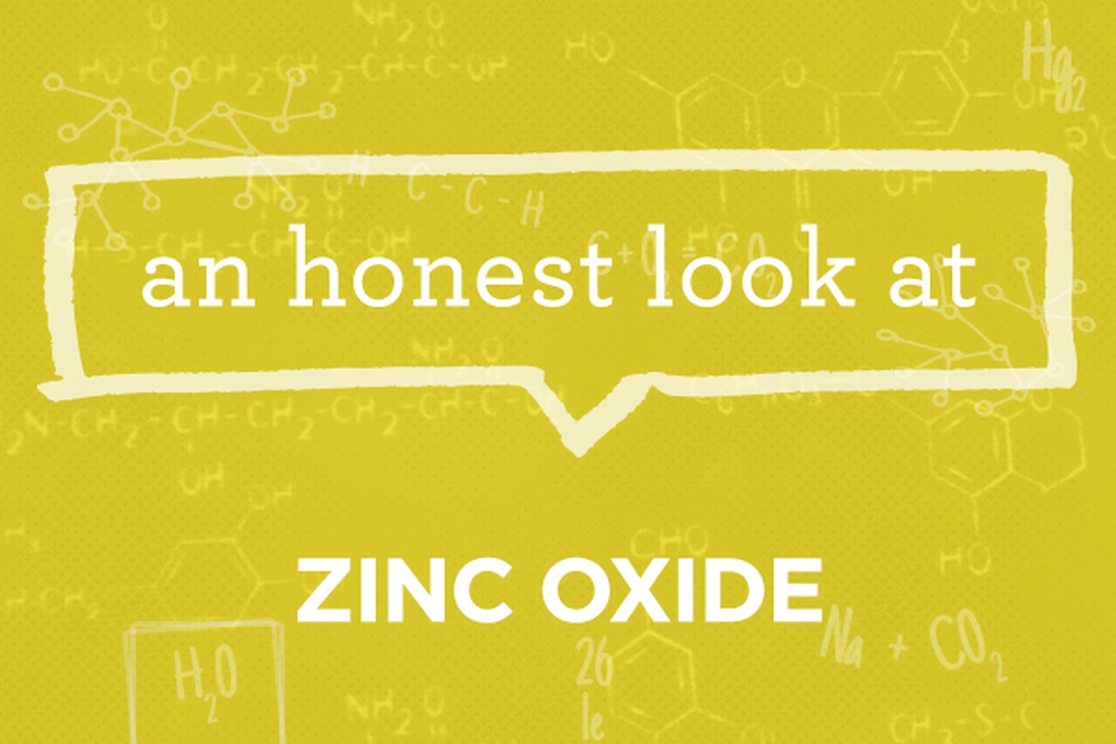This is part of our ongoing series helping consumers better understand chemicals, chemistry, and product formulations. We translate the science, bust the myths, and give you an honest assessment, so you can make informed choices for your family!
Ingredient:
Zinc Oxide
What it is:
Zinc Oxide is a white powdered mineral that it is found in nature, but not commonly, so commercial zinc oxide is made in a laboratory (mimicking natural processes to create a ‘nature identical mineral’). One of the primary ways zinc oxide is made is by subjecting mined metallic zinc (aka ‘zincite’) to very high heat, which releases zinc vapors that react with the oxygen in the air to create zinc oxide (1). [Quick fact: This process is known as the “French process” because it was popularized in France back in 1844(1).]
What it does:
Zinc oxide is a multi-functional mineral that’s used in everything from foods and first aid tapes to cosmetics and personal care products. One of the oldest recorded uses of zinc oxide is in medicinal topical ointments dating back to the 1st century A.D. in Greece (2). It’s still a commonly used mineral in skin creams today (like diaper rash creams) because it helps reduce and prevent redness and inflammation, as well as soothe and heal the skin (3-8).
Zinc oxide is also one of only 17 active ingredients currently approved by the FDA for use in sunscreens. And, it is the only single active ingredient that provides broad spectrum protection against UVA1, UVA2 (yes, there are 2 kinds of these rays), and UVB rays (9,10)!
Why we use it:
We make all of our products with the safety of you and your loved ones in mind, and zinc oxide has a very long history of safety.* Non-nano zinc oxide is the only active ingredient you’ll find in our Sunscreen Lotion and our Sunscreen Stick. You’ll also find non-nano zinc oxide in our Honest Diaper Rash Cream as the active ingredient that helps to reduce and prevent redness and inflammation.
What’s the difference between non-nano and nano zinc oxide?
“Non-nano” and “nano” refer to the size of the particles of zinc oxide. The range for "non-nano" is 100 nanometers (nm) or greater, while "nano" zinc oxide (used because it is non-whitening) is typically 10-20 nm in size. To give you a sense of how small that is, one nanometer is a billionth of a meter. To give even more context, here are comparisons using more tangible sizes:
- There are 25,400,000 nanometers in an inch (11).
- A sheet of newspaper is about 100,000 nanometers thick (11).
Nanoparticles are currently included in our Honestly Free Guarantee (list of ingredients our products are made without) because their very small size gives them unique properties compared to their natural particle counterparts. For example, a particle that naturally is too big to be absorbed by human skin could be shrunken down to a level where it easily passes through the skin and even penetrates the walls of cells (12). Since plants, animals and humans are built from cells that have never before interacted with these novel nanoparticles, we have little understanding about potential biological or toxicological impacts. We firmly believe this is something that should be comprehensively studied before releasing them into our environment and using them in everyday products. Therefore, while many other sunscreen manufacturers use nano-sized titanium dioxide and zinc oxide, we only use non-nano zinc oxide in our products.
*Zinc oxide does have risks associated with it when inhaled in occupational settings. This is not a possibility with Honest products . Cooper, R. G. (2008). Zinc toxicology following particulate inhalation. Indian journal of occupational and environmental medicine, 12(1), 10.
References:
- Kołodziejczak-Radzimska, A., & Jesionowski, T. (2014). Zinc oxide—from synthesis to application: a review. Materials, 7(4), 2833-2881.
- Craddock, P. T. (2008). "Mining and Metallurgy, chapter 4". In Oleson, John Peter.The Oxford Handbook of Engineering and Technology in the Classical World. Oxford University Press. pp. 111–112. ISBN 0-19-518731-8.
- Agren, M. S. (1989). Studies on zinc in wound healing. Acta dermato-venereologica. Supplementum, 154, 1-36.
- Ågren, M. S., Chvapil, M., & Franzén, L. (1991). Enhancement of re-epithelialization with topical zinc oxide in porcine partial-thickness wounds.Journal of Surgical Research, 50(2), 101-105.
- Gupta, M., Mahajan, V. K., Mehta, K. S., & Chauhan, P. S. (2014). Zinc Therapy in Dermatology: A Review. Dermatology research and practice, 2014.
- Otto, C. C., & Haydel, S. E. (2013). Microbicidal clays: composition, activity, mechanism of action, and therapeutic application. Microbial Pathogens and Strategies for Combating Them: Science, Technology and Education, Méndez-Vilas A (ed). Formatex Research Center: Badajoz, 2, 1169-1180.
- Hoggarth, A., Waring, M., Alexander, J., Greenwood, A., & Callaghan, T. (2005). A controlled, three-part trial to investigate the barrier function and skin hydration properties of six skin protectants. Ostomy/wound management,51(12), 30-42.
- Lansdown, A. B. G. (1996). Zinc in the healing wound. The Lancet, 347(9003), 706-707.
- Skin Cancer Foundation. (n.d.). Retrieved April 21, 2015, from http://www.skincancer.org/prevention/sun-protection/sunscreen/the-skin-cancer-foundations-guide-to-sunscreens
- Pinnell, S. R., Fairhurst, D., Gillies, R., Mitchnick, M. A., & Kollias, N. (2000). Microfine zinc oxide is a superior sunscreen ingredient to microfine titanium dioxide. Dermatologic surgery, 26(4), 309-314.
- What is Nanotechnology? (n.d.). Retrieved March 01, 2016, from http://www.nano.gov/nanotech-101/what/definition
- Verma, A., & Stellacci, F. (2010). Effect of surface properties on nanoparticle–cell interactions. Small, 6(1), 12-21.
We aim to provide you with the most honest and credible information possible. This article was reviewed for accuracy by The Honest Team and its internal technical experts.
blog_review_statement



